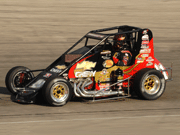
Midget (Full Size)

Midget race cars were introduced in the USA in the 1930s and raced on short 1/5 mile (0.32 km) dirt tracks. They were the original home-built race cars and their garage builders made use of every available automotive (and sometimes non-automotive) part they could use. Some cars were even powered by outboard boat motors.
Modern amateur cars have advanced in terms of technology, but the racing has the same premise: Drive as quickly around a dirt or paved oval race track. They are characterized by their scratch-built single seat chassis, 4 cylinder front-engine, rear-drive layout, and encompassing roll cage.
Racing is run worldwide on local tracks, with the largest racing participation in the USA.
| Power and Weight Stats | |
| Horsepower (Typical Range) | 300-400 |
| Race Weight (Typical Range) | 476-544 kg 1050-1200 lb |
Design and Construction
Build Your Own Midget Race Car
Knowledge Level
Due to the scratch-built nature of midget cars, you should be knowledgeable in handling, chassis, suspension, powertrain, aerodynamic and safety design. These six major areas of the car design work as an integrated unit and the designer must have an understanding of how changes to one area affect the others. Much of the design work is iterative, meaning re-designing areas based on new changes to another area. After the iterations are completed, the design will be complete and optimized.
Understanding the handling and suspension of the live axle configuration and the springing/damping aspects are especially helpful in the design and tuning of midget race cars.
Design Challenges
Weight Distribution: Because midget cars run on oval tracks as opposed to road courses, they are generally configured to optimize counter-clockwise or left turns.
Suspension: Maximizing the compliance with the track is of key importance. Axle, wheel and tire weights (Unsprung weight) affect the compliance of the suspension, which in turn affects handling, so keeping all these components as light as possible is an advantage.
The cars use stagger (larger outside tire) and offset (right side tire farther from the chassis than left side) to manage weight transfer, as well as ride height and springs/shocks. Adjustability in these areas must be designed into the car or tuning options will be very limited. At any given track, at any given race, the surface conditions might dictate tuning of these suspension components to provide more/less "bite" and tightening or loosening the rear of the car (understeer or oversteer).
The suspension link locations impact the chassis design.
Chassis: Providing openings to make internal components accessible for maintenance is also important.
Powertrain: Weight distribution is heavily impacted by engine position, especially on cars with as short a wheelbase as Midgets. Intake, Cooling and exhaust need to be considered in relation to chassis design, bodywork and aerodynamics.
Aerodynamic: Minimizing the drag created by the bodywork and frontal area will maximize speed on straights. If the drag reductions do not interfere with the car's other systems or break the regulations, then there may be some merit.
Safety: Modern Midget cars require a full roll structure integral to the chassis, with a racing seat/harness. Protection for fuel storage, fire protection, and side and rear bumper bars for impacts are also mandatory.
If you intend to race under a sanctioning body, always read and understand the regulations of your chosen racing class before designing or building any race vehicle.
Design Resources
Learn the basics about race cars and race car design from our free online knowledge series
Download our free race car design aids to assist you designing your race vehicle.
In-depth books and learning resources we recommend for midget car design.
Join our forum to ask and find answers to your midget car design/construction questions.
Construction Challenges
Ensuring the chassis is dimensionally accurate and straight is key. The use of a solid, flat and level build space is important. Jigs are often used in this case to ensure that structural tubing stays in alignment during welding/brazing.
The builder should have solid joining and metal working knowledge and skills when fabricating the chassis/rollcage/suspension. While mild steel (1018/1020) is very forgiving, some metals are best welded using a specific method (mig/tig) and some require heat treatments before and following welding to restore their toughness and strength.
Having sufficient space for the chassis and bodywork construction is important, as a cramped workshop can be difficult to work in.
The tools to fabricate the chassis and bodywork can add considerably to the cost of your project if you don't already have a workshop, but borrowing or renting items is also an option.
Build Costs
Many components for an amateur-built midget car can be sourced from midget parts manufacturers. In some cases, where permitted by regulations, parts can be sourced from production cars. This will lower the overall cost. Components that are specific to racing are also generally what cause the build costs to rise, but many components must be of high quality, such as a fuel safety cell and therefore care must be taken not to "Go cheap" in the wrong places.
Build Effort
Because the car is scratch-built, there will be significant effort in design and construction. There is however, an equally great satisfaction and sense of accomplishment at being one of the few people in the world who have built their own race car from the ground up! Many race car manufacturers also started this way, with the development of their own chassis leading them to build cars for others.
Racing Cost
Tires probably form the single largest consumable expense. Powertrain rebuilds and crash repairs may be more significant than other race car types, depending on the engine type and frequency they occur.
Transportation and Support Equipment
Trailering required.

